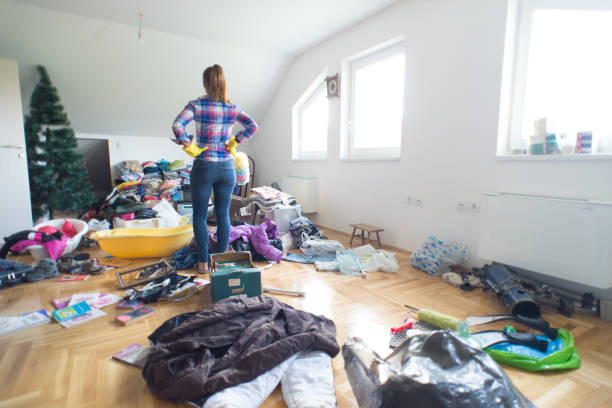Getting a Handle on Clutter - Getting Started
At Home with UAEX
Learn from the best Extension Educators on being at home with UAEX!
Getting a Handle on Clutter - Getting Started
by Original content: Joy West | Blog post: Katie Cullum

When you walk into a room or closet do you say, “Someday I have GOT to clean this place up.” That day will never come unless you plan that “someday”. Sit down with your calendar and plan a day, a few hours or whatever you can spare to start your declutter journey. Will you get it all done in a short time? Doubtful, but you will at least have started and can motivate yourself to plan a second (or third, or fourth) time to clean up your out-of-control space.
Many people procrastinate because they don’t know where to start. Getting rid of clutter means throwing it away, recycling it, donating it, or (possibly) selling it. Get four containers or boxes, one for each category plus a laundry basket for items that need to be put in their correct place in another room.
Decide where to begin, for example start at the door with the items on your left and plan to work your way around. Start with the first item you see that you know what to do with. If it is trash, put it in the trash box, if it goes somewhere else put it in the laundry basket to put away later. Pick up items one by one and decide which container they go in.
Set a time limit before you start, maybe use a timer. Don’t leave the area during that time, especially to put something away (you may never get back). When the time is up, congratulate yourself for a job well done. Throw out the trash items, return the laundry basket items to their proper place and plan the next time to work on the clutter area or other area. It’s a good idea to have someone help you, to make the task less burdensome. When you run into items you can’t decide what to do with, they may help you decide what to do.
When it is difficult to decide about an item, ask yourself a few questions.
· How long has it been since I used this?
· Do I like it?
· Does it work properly, or is it broken?
· Do I have more of this kind of thing, and how many do I need?
· If I keep this, what will I get rid of to make room for it?
· Can I locate this information somewhere else if I need it?
If you plan to repair an item, be realistic. Can it be repaired? Some items can’t be. How much will it cost? Many items cost more to repair than to replace. Have you already replaced the item? It’s unlikely you will repair the old one.
If you plan to recycle an item, know what items are accepted in your area. Look for hazardous waste locations or events in your area for things like paint, tires, pesticides, used motor oil and used batteries. There may be a special place or event to recycle electronics like broken computers and televisions.
If you plan to donate an item, find out the organizations or drop off areas for clothing and household items. Call to make sure what items are accepted. Some organizations will pick up large items like furniture. If you itemize deductions, ask for a receipt. Search for organizations that accept usable computers, gaming systems, and craft supplies. Even youth organizations and churches may want them.
If you plan to sell an item, decide how to sale it. Yard sale, swap meet, or flea markets are an option. Is there a resale or consignment shop in your area? Investigate internet auction sites or other sites where you can register and sell used items. Anything that doesn’t sale donate it, but don’t put it back in your home.
This information can get you started on your declutter journey. But there is much more to do to get a handle on clutter. Check out the information from the University of Illinois Extension.
